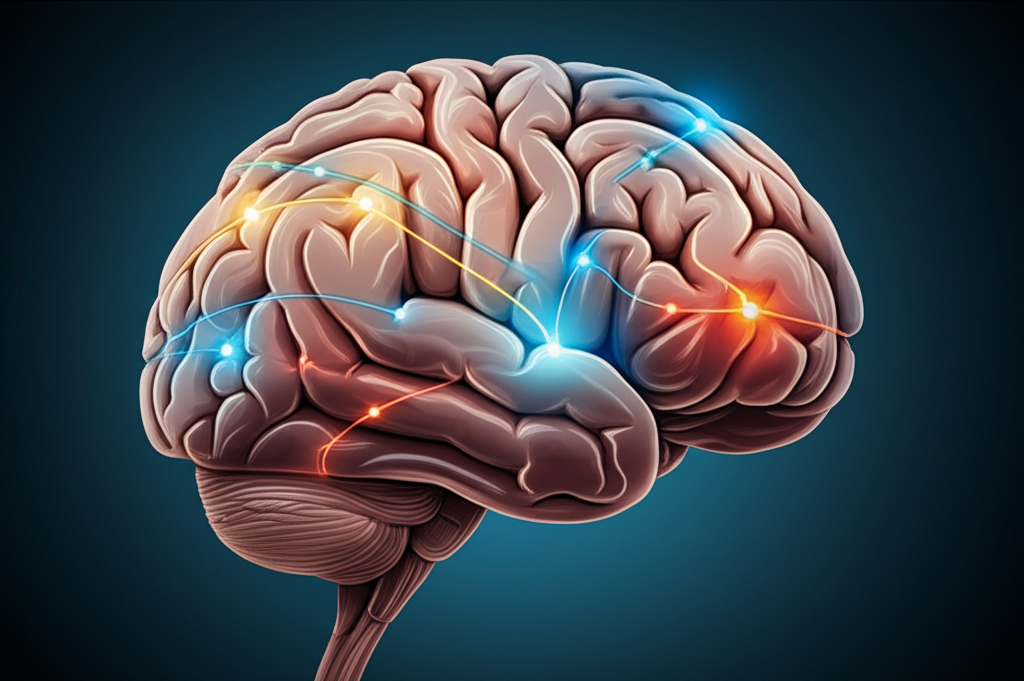Have you ever felt frustrated while studying, re-reading material repeatedly only to forget it days later? You’re alone. In today’s world of constant information flow, learning efficiently is more crucial than ever, yet many traditional study methods fall short, leading to slow progress and frustration. Understanding how our brains truly learn, based on cognitive science, reveals powerful strategies that can dramatically improve your speed and retention. This post explores specific, proven science-backed techniques designed to help you learn faster, remember longer, and understand better. We will cover practical methods and essential lifestyle factors to optimize your brain for peak learning performance. Learn more about the general principles of learning science from resources like Psychology Today.
Understanding the Fundamentals: How Your Brain Learns
Learning isn’t just passively absorbing information; it’s an active process that physically changes your brain. This is thanks to neuroplasticity, the brain’s incredible ability to reorganize itself by forming new neural connections throughout life. When you learn something new, you are literally rewiring your brain.
Memory formation involves several stages: encoding (getting information in), consolidation (stabilizing it), and retrieval (getting it back out). Information typically moves from temporary working memory to short-term memory and, if consolidated effectively, into durable long-term memory. Techniques aligned with these biological processes are far more effective because they work with your brain’s natural mechanisms, rather than against them.
Core Science-Backed Techniques for Accelerated Learning
These techniques leverage how the brain forms and retrieves memories to make your study time more effective.
Technique 1: Spaced Repetition – Beating the Forgetting Curve
Detailed Explanation: Spaced repetition is an evidence-based learning technique where you review material at increasing intervals over time. Instead of cramming, which leads to rapid forgetting, you revisit information just as you’re about to forget it.
Scientific Basis: This method directly combats Hermann Ebbinghaus’s Forgetting Curve, which shows how quickly we forget new information without review. By spacing out reviews, you interrupt the forgetting process, strengthening the memory trace each time. This involves desirable difficulty – the slight effort required to recall makes the memory more robust.
Practical Application: Popular tools like Anki and Quizlet use algorithms to schedule reviews automatically. You can also implement it manually with flashcards, reviewing them less often as they become easier.
Technique 2: Active Recall (Retrieval Practice) – The Power of Testing Yourself
Detailed Explanation: Active recall means deliberately trying to retrieve information from memory without looking at your notes or textbook. It’s about testing yourself constantly.
Scientific Basis: The testing effect demonstrates that retrieving information significantly strengthens the memory trace more than simply re-studying it. Re-reading can create a false sense of familiarity, while active recall forces your brain to work, proving what you truly know and what you don’t.
Practical Application: After reading a page, close the book and try to recall the main points. Use practice questions, explain concepts aloud without notes, or use the ‘blurting’ method where you write everything you remember on a topic.
Technique 3: Interleaving – Mixing It Up for Deeper Understanding
Detailed Explanation: Interleaving involves mixing different subjects, topics, or problem types within a single study session. This contrasts with blocked practice, where you focus on one topic intensely before moving to the next.
Scientific Basis: It forces your brain to make connections and distinguish between concepts. When you encounter a problem, you must first identify what kind of problem it is and which strategy to use, enhancing discriminative contrast and understanding the relationships between ideas.
Practical Application: Instead of studying Chapter 1, then Chapter 2, then Chapter 3 of one subject, you might study a bit of Chapter 1 from Subject A, then a bit of Chapter 2 from Subject B, then Chapter 3 from Subject C, or mix different types of math problems.
Key Takeaways: Core Techniques
| Technique | Core Idea | Primary Benefit | Example Tools/Method |
|---|---|---|---|
| Spaced Repetition | Review at increasing intervals | Long-term memory retention | Anki, Quizlet, Flashcards |
| Active Recall | Test yourself | Strengthens retrieval | Self-quizzing, Blurting |
| Interleaving | Mix topics/problems | Deeper understanding, Transfer | Alternating subjects/types |

Optimizing Your Brain & Environment for Peak Learning Performance
Your ability to learn isn’t just about technique; it’s also deeply connected to your physical and mental state.
The Indispensable Role of Sleep for Consolidation
Sleep isn’t rest for the brain; it’s crucial work time. During sleep, particularly REM and slow-wave sleep, the brain consolidates memories, integrating new information with existing knowledge. Sleep deprivation severely impairs focus, concentration, working memory, and overall cognitive function. Aim for consistent sleep, optimize your sleep environment (dark, quiet, cool), and consider strategic napping.
Fueling Learning: Nutrition and Hydration
What you eat directly impacts brain health and performance. A diet rich in Omega-3 fatty acids, antioxidants, and complex carbohydrates supports cognitive function. Dehydration, even mild, harms focus, attention, and memory. Prioritize balanced meals, avoid sugar crashes with smart snacking, and drink water consistently throughout the day.
Exercise: The Physical Boost for Mental Acuity
Physical activity increases blood flow to the brain, delivering vital oxygen and nutrients. Exercise boosts BDNF (Brain-Derived Neurotrophic Factor), a protein crucial for neuron growth, survival, and plasticity. Regular exercise improves memory, attention, processing speed, and mood. Incorporate aerobic exercise, strength training, and even short movement breaks into your routine.
Creating Your Optimal Learning Environment & Cultivating the Right Mindset
Minimize distractions by setting up a dedicated study space. Practice single-tasking and focused attention; techniques like the Pomodoro Technique (focused work intervals followed by short breaks) can help. Adopt a growth mindset (researched by Carol Dweck), believing your abilities can be developed through effort. This resilience enhances motivation and persistence when facing challenges.

Advanced Strategies & Refinements for Mastery
Beyond the core techniques, these methods help solidify complex knowledge and manage information.
The Feynman Technique: Simplify to Solidify
This technique involves teaching a concept to someone else (or yourself, imagining a novice).
- Choose a concept.
- Explain it in simple terms as if to a child.
- Identify where your explanation is unclear or you get stuck.
- Go back to the source material to fill those gaps.
- Simplify the explanation further.
This process exposes knowledge gaps and forces deep understanding.
Chunking: Managing Information Overload
Chunking is grouping smaller pieces of information into larger, meaningful units or “chunks.” This reduces the load on your working memory, allowing you to process more complex ideas. Examples include grouping digits in a phone number or seeing code blocks as single units rather than individual lines.
Elaboration: Weaving a Richer Knowledge Network
Elaboration means connecting new information with what you already know. This involves asking “why” and “how,” creating analogies, generating examples, and thinking about relationships. This builds a richer, more interconnected knowledge network, making information easier to retrieve and apply in different contexts. Techniques like mind mapping facilitate elaboration.
Putting It All Together: Implementing & Sustaining Learning Habits
Integrating these techniques can feel daunting at first. Start small by choosing one or two methods, like active recall or spaced repetition for a specific subject. Schedule dedicated time for practice sessions, just like you would a class. Consistency is key; short, regular practice is more effective than sporadic cramming.
Track which techniques work best for you and adapt as needed. Be patient with yourself – developing effective learning habits takes time and practice, but the payoff in speed, retention, and understanding is significant. Experiment, refine, and make learning a skill you continuously improve.
Summary:
Effective learning is an active, science-informed process. By understanding how the brain learns through neuroplasticity and memory consolidation, we can leverage techniques like Spaced Repetition, Active Recall, and Interleaving to combat forgetting and deepen understanding. Supporting your brain with proper sleep, nutrition, exercise, and an optimal environment is equally crucial. Advanced methods like the Feynman Technique, Chunking, and Elaboration further refine your ability to grasp complex ideas. Implementing these strategies consistently transforms learning from a chore into an efficient, rewarding journey.
Conclusion: Your Journey to Faster, More Effective Learning
You now have a powerful toolkit of science-backed strategies to enhance your learning. Forget the inefficiency of passive methods. By applying techniques like spaced repetition, active recall, and interleaving, supported by healthy lifestyle choices, you can significantly improve how quickly you learn and how well you retain information. Effective learning isn’t an innate talent; it’s a skill cultivated through deliberate practice. Embrace these proven methods, experiment to find what works best for you, and unlock your full potential as a faster, more effective learner.
FAQ
Q1: Can I use these techniques for any subject?
A1: Yes, these techniques are based on fundamental cognitive principles and are applicable across a wide range of subjects, from languages and history to math and science. You might adjust how you apply them (e.g., flashcards for facts, recall for concepts, interleaving for problem-solving), but the core ideas are universal.
Q2: How long does it take to see results from these techniques?
A2: You may notice improvements in retention and understanding relatively quickly, perhaps within a few study sessions or weeks of consistent application. The full benefits, especially in long-term retention, compound over time with regular practice.
Q3: Is using apps like Anki or Quizlet essential for spaced repetition?
A3: While apps make implementing spaced repetition algorithms very efficient, they are not essential. You can use physical flashcards and a simple system to review them at increasing intervals. The key is the principle of spaced review, not the tool itself.
Q4: How can I integrate these techniques into a busy schedule?
A4: Start small. Choose one or two techniques that seem most relevant to your current learning goal. Instead of adding extra study time, replace less effective methods (like passive re-reading) with these active ones. Incorporate short review sessions using active recall or spaced repetition during commutes or breaks. Consistency in short bursts is highly effective.
Q5: Do I need to master all these techniques at once?
A5: Absolutely not. Trying to implement everything at once can be overwhelming. Begin with one or two that resonate with you the most. Once they become habits, gradually integrate other techniques. Focus on consistent practice and finding the combination that works best for your learning style and the material you’re studying.

